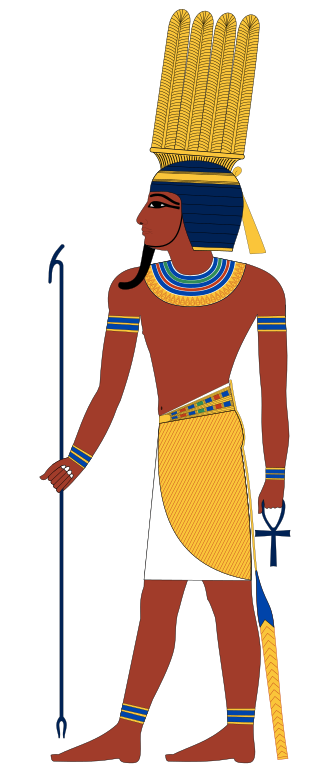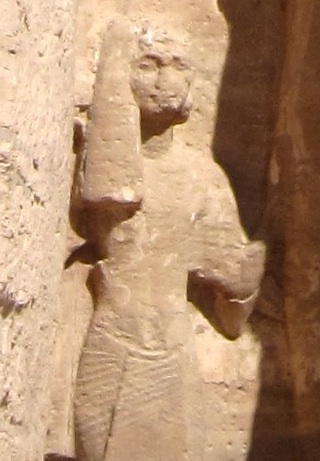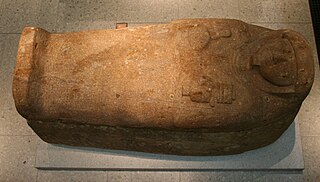Related Research Articles

In early Egyptian mythology, Anhur was a god of war who was worshipped in the Egyptian area of Abydos, and particularly in Thinis. Myths told that he had brought his wife, Mehit, who was his female counterpart, from Nubia, and his name reflects this—it means '(one who) leads back the distant one'.

Menpehtyre Ramesses I was the founding pharaoh of ancient Egypt's 19th Dynasty. The dates for his short reign are not completely known but the timeline of late 1292–1290 BC is frequently cited as well as 1295–1294 BC. While Ramesses I was the founder of the 19th Dynasty, his brief reign mainly serves to mark the transition between the reign of Horemheb, who had stabilized Egypt in the late 18th Dynasty, and the rule of the powerful pharaohs of his own dynasty, in particular his son Seti I, and grandson Ramesses II.

The necropolis of Draʻ Abu el-Naga' is located on the West Bank of the Nile at Thebes, Egypt, just by the entrance of the dry bay that leads up to Deir el-Bahari and north of the necropolis of el-Assasif. The necropolis is located near the Valley of the Kings.
Prince Khaemweset was the fourth son of Ramesses II and the second son by his queen Isetnofret. His contributions to Egyptian society were remembered for centuries after his death. Khaemweset has been described as "the first Egyptologist" due to his efforts in identifying and restoring historic buildings, tombs and temples.

The necropolis of El-Khokha is located on the west bank of the river Nile at Thebes, Egypt. The necropolis is surrounds a hill and has five Old Kingdom tombs and over 50 tombs from the 18th, 19th and 20th dynasties as well as some from the First Intermediate Period and the Late Period.
Hori may refer to:

Meryatum was an ancient Egyptian prince and High Priest of Re, the son of Pharaoh Ramesses II and Queen Nefertari.

The High Priest of Amun or First Prophet of Amun was the highest-ranking priest in the priesthood of the ancient Egyptian god Amun. The first high priests of Amun appear in the New Kingdom of Egypt, at the beginning of the Eighteenth Dynasty.
in Ancient Egypt, Paser II was the son of the High Priest of Min and Isis named Minmose. Paser came from a very well-connected family. One uncle was the High Priest of Amun Wennenefer and another uncle was the troop commander of Kush named Pennesuttawy. Through Wennenefer, Paser was related to Amenemone, Amenemope and Hori, the High Priest of Anhur.

The High Priest of Ptah was sometimes referred to as "the Greatest of the Directors of Craftsmanship". This title refers to Ptah as the patron god of the craftsmen.

Hori was the High Priest of Ptah at the very end of the reign of Ramesses II. Hori succeeded Neferronpet in office.
Nebwenenef was High Priest of Amun at the beginning of the reign of Ramesses II during the 19th Dynasty. Prior to that, Nebwenenef had served as High Priest of Anhur and High Priest of Hathor during the reign of Seti I and possibly even earlier.
The High Priest of Ra or of Re was known in Egyptian as the wr-mꜢw, which translates as Greatest of Seers.

Khay (Kh-'-y) was an Ancient Egyptian noble who served as Vizier in the latter part of the reign of Ramesses II, during the 19th Dynasty.

The ancient Egyptian noble Prehotep II was Vizier in the latter part of the reign of Ramesses II, during the 19th Dynasty.
Pennesuttawy was a Military Commander and Superintendent of the Southern Lands (Kush) during the beginning of the Nineteenth Dynasty of Egypt.
This page list topics related to ancient Egypt.

Wenennefer was an ancient Egyptian High Priest of Osiris at Abydos, during the reign of pharaoh Ramesses II of the 19th Dynasty.
Hori was a High Priest of Anhur during the reign of Ramesses II. He was the son of the High Priest of Amun Parennefer called Wennefer and his wife Isis. He may be identical to the High priest of Amun mentioned on the statue of the Overseer of the Charioteers named Kanakht.
Minmose was the High Priest of Anhur during the reign of Ramesses II
References
- ↑ M.L. Bierbrier, Historical Dictionary of Ancient Egypt, 2008
- ↑ Kampp, F., and K. J. Seyfried, Eine Rückkehr nach Theben, Antike Welt, Mainz 26 (1995), 325-342. (ill. incl. colours, plans).
- ↑ Kampp-Seyfried, Friederike, Die Verfemung des Namens pA-rn-nfr, in: Stationen. R. Stadelmann gewidmet, 303-319. (pl.).
- ↑ Kampp, F., Vierter Vorbericht über die Arbeiten des Ägyptologischen Instituts der Universität Heidelberg in thebanischen Gräbern der Ramessidenzeit, MDAIK 50 (1994), 175-188. (fig., plans, pl.).
- 1 2 3 4 5 6 Kitchen, K.A., Ramesside Inscriptions, Translated & Annotated, Translations, Volume III, Blackwell Publishers, 1996, pg 209, 193-195, 315